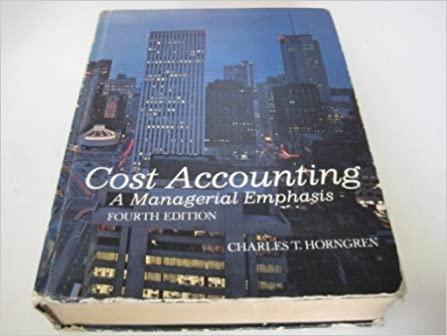Multiple Choice (CMA adapted) The Organet Stamping Company manufactures a variety of products made of plastic and
Question:
Multiple Choice (CMA adapted) The Organet Stamping Company manufactures a variety of products made of plastic and aluminum components.
During the winter months substantially all of the production capacity is devoted to the production of lawn sprinklers for the following spring and summer season. Other products are manufactured during the remainder of the year.
Because a variety of products are manufactured throughout the year, factory volume is measured by production labor-hours rather than units of product.
Production and sales volume have grown steadily for the past several years, as can be seen from the following schedule of standard production labor content of annual output expressed in hours:
19=3 32,000 1@2 30,000 WWe1 27,000 OBO 28,000 ISLS 26,000 The company has developed standard costs for its several products. Standard costs for each year are set in the preceding October. The standard cost of a sprinkler for 19_4 was $2.50, computed as follows:
Direct materials:
Aluminum .2 Ibs. @$ .40 per Ib. $ .08 Plastic 1.0 Ibs. @_ .38 per Ib. 38 Production labor 3 hrs. @ 4.00 per hr. e220 Overhead (calculated using 30,000 production labor-hours as denominator Capacity):
Variable 3 hrs. @ 1.60 per hr. 48 Fixed .3 hrs. @ 1.20 per hr. 36 Total $2.50 During February 19_4, 8,500 good sprinklers were manufactured. The following costs were incurred:
Materials requisitioned for production:
Aluminum 1,900 Ibs. @$ .40 per Ib. $ 760 Plastic:
Regular grade 6,000 Ibs. @ _ .38 per Ib. 2,280 Low grade* 3,500 Ibs. @ .38 per Ib. 1,330 Production labor:
Straight time 2,300 hrs. @ 4.00 per hr. 9,200 Overtime 400 hrs. @ 6.00 per hr. 2,400 Overhead:
Variable 5,200 Fixed 3,100 Total costs charged to manufacturing departments $24,270 Material-price variations are not charged to production but to a material- price-variation account at the time the invoice is entered. All materials are carried in inventory at standard prices. Material purchases for February were:
Aluminum 1,800 Ibs. @$ .48 per lb. $ 864 Plastic:
Regular grade 3,000 Ibs. @ .50 1,500 Low grade* 6,000 Ibs. @ .29 1,740 - Owing to plastic shortages, the company was forced to purchase lower-grade plastic than called for in the standards. This increased the number of sprinklers rejected on inspection.
Every item below is related to the above facts and should be answered on the basis of those facts. Show your computations. Choose the best answer: 1. The total variation from “standard cost applied” of the costs charged to manufacturing departments for February 19_4 is
(a) $3,080 unfavorable,
(b) $3,020 unfavorable,
(c) $3,140 favorable,
(d) $3,020 favorable,
(e) some other amount.
2. The standard material quantities already include an allowance for acceptable material scrap loss. In this situation the material efficiency variations would most likely be caused by
(a) defective aluminum,
(b) improper processing by labor,
(c) inadequate allowance for scrap loss,
(d) substitute plastic,
(e) none of these reasons.
3. The spending or budget variation for the fixed portion of the overhead costs is
(a) $100 unfavorable,
(b) $60 favorable,
(c) zero,
(d) not calculable from the problem,
(e) not listed above.
4. The labor-efficiency variation is the difference between standard laborhours allowed for output achieved and
(a) 2,300 hours,
(b) 2,700 hours,
(c) 2,900 hours,
(d) 2,500 hours,
(e) some other amount.
5. The production labor-price variation is
(a) $0,
(b) $600 unfavorable, (c)
$800 unfavorable,
(d) $1,400 unfavorable
(e) $2,400 unfavorable.
6. The manufacturing overhead denominator variation is
(a) the result of inadequate cost-control effort,
(b) the result of sales volume exceeding production volume,
(c) the result of actual production hours exceeding standard production hours of output,
(d) the result of the overapplication of fixed cost to output,
(e) not the result of any of these reasons.
7. The variable-overhead-budget variation is
(a) $1,120 unfavorable, (b)
$1,220 unfavorable,
(c) $1,160 unfavorable,
(d) $1,280 unfavorable,
(e) none of these.
8. The variations of material prices from standard would
(a) best be reported as materials-price variations—$36 favorable,
(b) best be reported as materialsprice variations—aluminum, $144 unfavorable; plastic, $180 favorable,
(c) best be reported as materials-price variations—aluminum, $144 unfavorable; plastic, $360 unfavorable; material substitution, $540 favorable, (d)
best be reported as materials-price variations—aluminum, $144 unfavorable;
plastic, $360 unfavorable; price difference due to plastic substitution not reported
(e) not be reported because material prices are uncontrollable.
Step by Step Answer:






